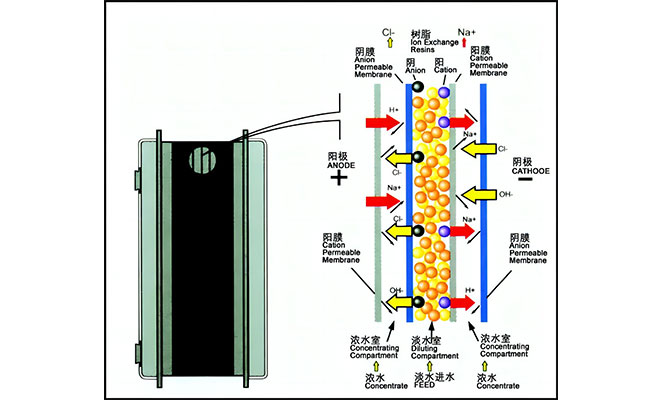EDI is a pure water manufacturing technology that combines ion exchange technology, ion exchange membrane technology and ion electromigration technology. It skillfully combines electrodialysis and ion exchange technology, uses high voltage of electrodes at both ends to move charged ions in water, and cooperates with ion exchange resin and selective resin membrane to accelerate the removal of ions, so as to achieve the purpose of water purification. During EDI desalination, ions are removed by ion exchange membrane under the action of electric field. At the same time, water molecules generate hydrogen ions and hydroxide ions under the action of electric field, which continuously regenerate the ion exchange resin to keep the ion exchange resin in the best state.
Item | Reference value |
Nominal Recovery: | 90–95% |
EDI Water Quality: | 15–18 MΩ.CM(25℃) |
FEED CONDUCTIVITY (INCLUDING CO2): | < 10 µs/cm(25℃) |
Operating Temperature: | 50–100° F |
Maximum Inlet Pressure: | 100 psig |
Minimum Inlet Pressure: | 60 psig |
Expected Pressure Drop: | 30–40 psig |
Electrical Requirement: | 380 VAC, 3-phase, 50 Hz. |

EDI Process
EDI desalination process is to exchange ions in water with hydroxide ions or hydrogen ions in ion exchange resin, and then migrate these ions into concentrated water;
The above exchange reaction takes place in the freshwater chamber of the module. In the freshwater chamber, the hydroxide ion in the anion exchange resin exchanges with the anion in the water, and the hydrogen ion in the cation exchange resin exchanges with the cation in the water;
The exchanged ions migrate along the surface of the resin ball under the effect of the DC electric field and enter the concentrated water chamber through the ion exchange membrane;
The negatively charged anions are attracted by the anode, and these ions enter the adjacent concentrated water chamber through the anion membrane, while the adjacent cation membrane membrane does not allow them to pass through. These ions are blocked in the concentrated water, while the positively charged cations are attracted by the anion anion, and these ions enter the adjacent concentrated water chamber through the cation membrane, while the adjacent anion membrane does not allow them to pass through. These ions are blocked in the concentrated water.
In concentrated water, ions from both directions maintain electric neutrality. At the same time, the amount of current is proportional to the amount of ion migration. The amount of current consists of two parts, one part from the migration of removed ions, and the other part from the migration of water itself ionized into H+and OH - ions;
When the water flow passes through the fresh water chamber and the concentrated water chamber, the ions gradually enter the adjacent concentrated water chamber from the fresh water chamber and are carried out of the EDI module by the concentrated water;
Under the action of higher voltage gradient, water will generate a large amount of H+and OH- through electrolysis. These generated H+and OH- will continuously regenerate the ion exchange resin. Therefore, the ion exchange resin in EDI module does not need chemical regeneration;
The above is the desalination process of EDI.
Regeneration of acid and alkali is not needed.
Zero discharge; no discharge of wastewater.
The running is continuous and the water quality is stable.
Modularization design is adopted so as to facilitate extension.
Less space is occupied.
Phone:
E-mail:
Address:
Room 1904, Building 10, No. 218, Jiqingmen Street, Jianye District, Nanjing, Jiangsu, China